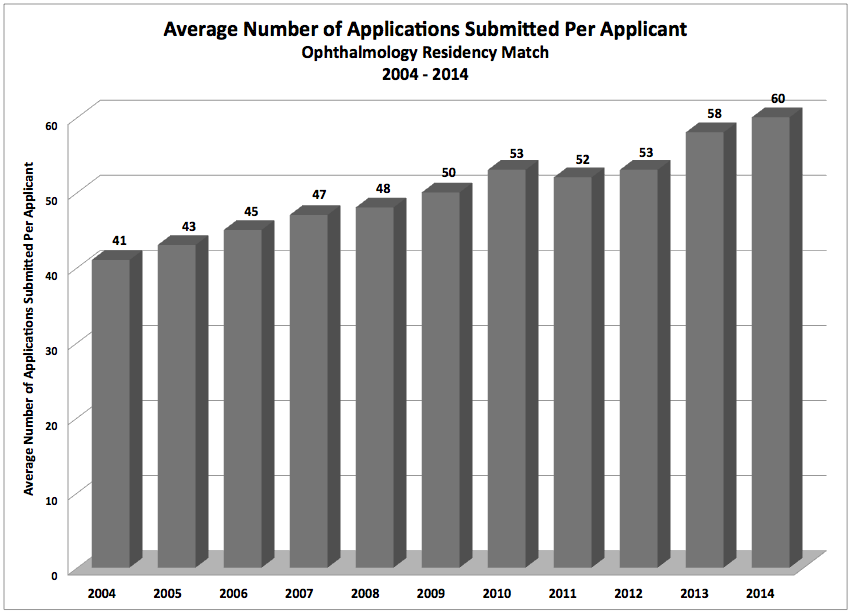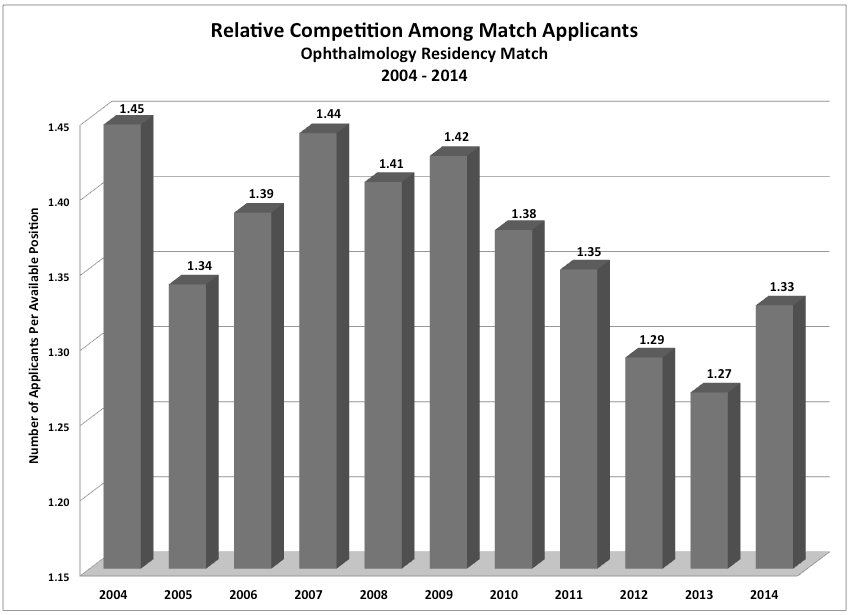Just a few weeks ago, over 600 medical students nervously waited for a phone call or email from ophthalmology residency programs around the United States, congratulating 460 of those students on having secured a residency position in an ACGME-accredited ophthalmology residency program and allowing them to advance one step closer toward their goal of becoming an ophthalmologist. As you may have read in the previous article, “Remembering Ophthalmology Residency Match Day,” the experiences of applicants on Match Day are unique, entertaining, and unforgettable. Now that Match Day has passed, we look to the Ophthalmology Residency Match Results to provide insight for students hoping to match in the future, applicants who just recently matched, and current ophthalmologists grateful to have matched years ago, including the Chairman of a Department of Ophthalmology who, during a residency interview with me, candidly admitted, “I’m just glad I don’t have to go through the match again! There’s no way I would have matched if I were applying today!”
Each year, the Ophthalmology Residency Match Results are published online on the SF Match website. Below is a brief summary of a few of the most interesting trends I see when analyzing the Ophthalmology Residency Match Results for the years 2004 -2014.
Average USMLE Step 1 Score
As can be seen above, the average USMLE Step 1 score among matched and unmatched applicants has increased over the last decade. Not shown on the graph above, however, is the percent increase from year to year. Between the 2013 match class and the 2014 match class, the average USMLE Step 1 score increased 1.3%, or from 239 to 242, representing the second highest year-to-year increase, second only to the increase from 2008 to 2009. Among unmatched applicants, the average USMLE Step 1 scores also increased with this year’s match class, from 222 to 226, a 1.8% increase over 2013. It should be noted that this increase in Step 1 score among all applicants is consistent with what I believe to be the general trend of increasing average USMLE Step 1 scores over time among all applicants and within all specialties.
Average Number of Applications Submitted Per Applicant
In this figure we see the trend of applicants submitting an increasing number of applications each year. With just 117 ACGME-accredited ophthalmology residency programs in the United States, the average 2014 match applicant submitted applications to over half of all possible programs. The current cost per program applied increases in the following stepwise fashion:
- Registration cost = $100
- Programs 1-10 = $60
- Programs 11-20 = $10/program
- Programs 21-30 = $15/program
- Programs 31-40 = $20/program
- Programs 41-117 = $35/program
Based on the cost breakdown above, the average 2014 match applicant applied to 60 programs, at a total price of $1310. As you are likely aware, a previously published study in the journal Ophthalmology indicated that applicants ranking more than 10 programs have a greater than 90% chance of matching, and as such, the $1310 is perceived by many applicants as a reasonable or even relatively minimal marginal cost to increasing an individual’s chance of matching and when considering the opportunity cost of foregoing a year’s salary as an ophthalmologist in the event one does not successfully match and must reapply the following year. The increasing number of applications sent each year reflects what I believe to be an inefficiency in the match system, as programs must sift through more and more applications each year, with some programs receiving three or four-hundred applications for 3-5 available positions. It will be interesting to see if either the marginal cost per additional application increases in coming years or whether the system as a whole will change to permit a maximum number of programs to which an applicant may apply. Clearly, the pricing structure is highly inelastic, as applicants are not very sensitive to changes in price, and will find a way to afford applying to enough programs to increase their chances at a successful match.
In my opinion, a maximum number of programs will never be established, as the successful match is based on the filling of all available positions, and deciding the ideal number of applications to submit is based on perceived competitiveness relative to peers, with highly competitive applicants applying to fewer programs compared to those who perceive themselves as less competitive relative to their peers, and must pay a higher price to balance for their perceived competitiveness. Speaking of relative competition within the ophthalmology residency match, take a look at this next figure.
Relative Competition Among Match Applicants
In the above figure, we see the relative competition among applicants for the years 2004 to 2014 based on the ratio of applicants who submitted a rank list to possible match positions. In 2014, for example, 611 applicants submitted a rank list, with 461 possible match positions, for a ratio of 1.33 (611/461) applicants per position. Said differently, if you were to take four applicants who submitted a rank list in 2014, those four applicants would be vying for three match positions. As you can see, the relative competition in 2014 was an increase from 2013, and also represented a change in the trend for years 2009-2013, where fewer and fewer applicants were vying for largely the same number of residency positions each year. In 2014, the number of applicants who submitted rank lists increased by nearly 5% relative to 2013. I am not certain that this number is statistically significant, though it does provide some insight to those who felt this year’s match was increasingly competitive compared to the match in recent years.
While not shown here, but to be highlighted in a future article, it is also interesting to note that while nearly every specialty has increased its number of residency positions annually since 2009, ophthalmology has only added two ACGME-accredited residency positions in the last six years. With the large baby-boomer population nearing retirement and needing treatment for age-related eye disease, and residency programs not increasing the number of ophthalmologists trained each year, ophthalmologists will be in high demand in the coming years. That being said, with cataract and other eye surgeries becoming much more efficient, perhaps the ophthalmologist of the future will be able to treat a larger per capita population than in the past. I am confident the AAO and other governing bodies within ophthalmology are well aware of the trends, so I’ll leave it up to them to make future projections and increase residency positions accordingly. The one thing that is for certain, however, is that the 2014 match had more applicants per possible match position than in the two prior years, though still considerably less than in the past decade as a whole.
As I hope you have been able to see in this simple analysis of the ophthalmology residency match results, ophthalmology remains a highly competitive specialty. What remains to be seen is if changes will be made to limit the number of possible applications submitted by each applicant and if/when additional residency positions will be added in the future. Congratulations to those that have successfully matched and best of luck to future applicants. As has been said in the past, “I’m just glad I don’t have to go through the match again!”
















This is an interesting article. Thankyou. I am planning to apply August 2016. Would we be able to correspond on questions I have about arranging away rotations? Thanks, Ryan from Florida.
Ryan – Thanks for your comment! Glad you liked the article. I did not personally do any away rotations but if you have other questions along the way I’m happy to help.
An insightful and thought provoking article. I, too am glad I don’t have to go through the match again.
I, too am thankful that I won’t have to go through the match again.